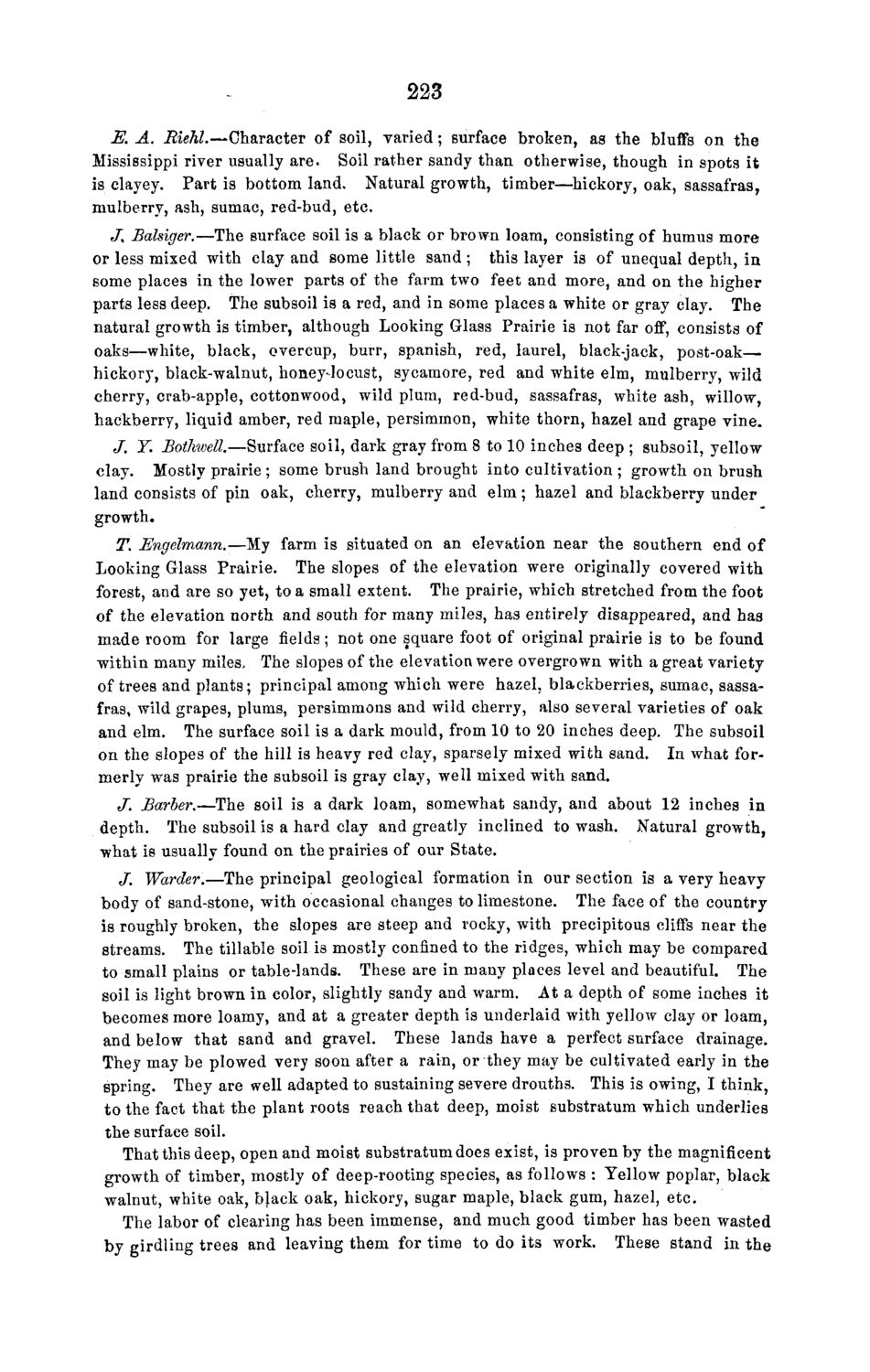| |
| |
Caption: Board of Trustees Minutes - 1868
This is a reduced-resolution page image for fast online browsing.

EXTRACTED TEXT FROM PAGE:
223 & A. Riehl.—Character of soil, varied; surface broken, as the bluffs on the Mississippi river usually are. Soil rather sandy than otherwise, though in spots it is clayey. Part is bottom land. Natural growth, timber—hickory, oak, sassafras, mulberry, ash, sumac, red-bud, etc. J% Balsiger.—The surface soil is a black or brown loam, consisting of humus more or less mixed with clay and some little sand ; this layer is of unequal depth, in some places in the lower parts of the farm two feet and more, and on the higher parts less deep. The subsoil is a red, and in some places a white or gray clay. The natural growth is timber, although Looking Glass Prairie is not far off, consists of oaks—white, black, overcup, burr, Spanish, red, laurel, black-jack, post-oak— hickory, black-walnut, honey-locust, sycamore, red and white elm, mulberry, wild cherry, crab-apple, cottonwood, wild plum, red-bud, sassafras, white ash, willow, hackberry, liquid amber, red maple, persimmon, white thorn, hazel and grape vine. J. Y. Bothwell.—Surface soil, dark gray from 8 to 10 inches deep ; subsoil, yellow clay. Mostly prairie ; some brush land brought into cultivation ; growth on brush land consists of pin oak, cherry, mulberry and elm; hazel and blackberry under growth. T. Engelmann.—My farm is situated on an elevation near the southern end of Looking Glass Prairie. The slopes of the elevation were originally covered with forest, and are so yet, to a small extent. The prairie, which stretched from the foot of the elevation north and south for many miles, has entirely disappeared, and has made room for large fields; not one square foot of original prairie is to be found within many miles. The slopes of the elevation were overgrown with a great variety of trees and plants; principal among which were hazel, blackberries, sumac, sassafras, wild grapes, plums, persimmons and wild cherry, also several varieties of oak and elm. The surface soil is a dark mould, from 10 to 20 inches deep. The subsoil on the slopes of the hill is heavy red clay, sparsely mixed with sand. In what formerly was prairie the subsoil is gray clay, well mixed with sand. J, Barber.—The soil is a dark loam, somewhat sandy, and about 12 inches in depth. The subsoil is a hard clay and greatly inclined to wash. Natural growth, what is usually found on the prairies of our State. J. Warder.—The principal geological formation in our section is a very heavy body of sand-stone, with occasional changes to limestone. The face of the country is roughly broken, the slopes are steep and rocky, with precipitous cliffs near the streams. The tillable soil.ia mostly confined to the ridges, which may be compared to small plains or table-lands. These are in many places level and beautiful. The soil is light brown in color, slightly sandy and warm. At a depth of some inches it becomes more loamy, and at a greater depth is underlaid with yellow clay or loam, and below that sand and gravel. These lands have a perfect surface drainage. They may be plowed very soon after a rain, or they may be cultivated early in the spring. They are well adapted to sustaining severe drouths. This is owing, I think, to the fact that the plant roots reach that deep, moist substratum which underlies the surface soil. That this deep, open and moist substratum does exist, is proven by the magnificent growth of timber, mostly of deep-rooting species, as follows : Yellow poplar, black walnut, white oak, bjack oak, hickory, sugar maple, black gum, hazel, etc. The labor of clearing has been immense, and much good timber has been wasted by girdling trees and leaving them for time to do its work. These stand in the
| |